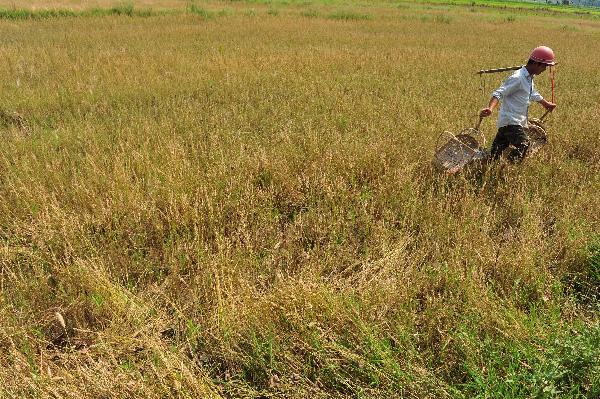Food prices soar as severe drought continues
As a severe drought continues in central and southern China, decreased crop yields have significantly pushed up prices of rice and vegetables.
 |
|
A villager walks in a dry paddy field in Zhengwenzhuang Village in Xintan Town of Honghu City, central China's Hubei Province, May 30, 2011. Hubei struggles with a devastated drought, whose fishermen living by Honghu Lake are unable to fish there anymore, as the drought has almost completely dried up the 413-square-kilometer lake. |
An area of nearly 7 million hectares of arable land has been affected by the drought in Hunan, Hubei, Jiangxi, Anhui and Shanghai provinces along the middle and lower reaches of the Yangtze River according to the latest statistics from the Office of State Flood Control and Drought Relief Headquarters (SFDH).
The average price of staple foods in 50 cities has increased significantly, and the price of some leaf vegetables has jumped 16 percent in one month, according to data from the National Bureau of Statistics.
The worst drought to hit Hunan Province in nearly a century has caused water shortages that have affected 1.11 million people in this central China province, said an official with the provincial flood control and drought relief headquarters.
China's "land of fish and rice" has seen its lowest levels of rainfall since 1910, according to the official. Further, as of Monday, 13 of Hunan's 14 major cities have been affected by the drought, the official said.
Over 10 million mu (about 709,000 hectares) of farmland in Hunan have been directly impacted by the drought, with 1.79 million mu of crops rendered unharvestable.
Additionally, water levels in 30 percent of Hunan's reservoirs have dropped below "acceptable" levels, preventing them from being used for irrigation, the official said.
The Hunan provincial government has already allocated 310 million yuan (about 47.8 million U.S. dollars) toward drought-relief efforts, including digging new wells and pumping water into the province from other areas.
Hunan's neighboring province Hubei is also overwhelmed by the lingering drought, with increasing cities and towns hit by severe or extreme drought, which will greatly damage crops and affect the natural environment.
In Anhui Province, a major rice and wheat production base in China, drought has threatened over eight million mu (533,333 hectares) of rice, which needed artificial irrigation. Water is also needed for the 23 million mu of wheat in the province, according to the provincial flood control and drought relief headquarters.
Shanghai is also experiencing its longest period of no precipitation in 138 years, having received only 132.9 mm of rainfall since the beginning of this year, the lowest level since 1873, according to a report released on Monday by the Shanghai Municipal Meteorological Bureau.
The drought has affected some 34.83 million people in five provinces along the Yangtze River according to the latest statistics SFDH.
 0
0 






